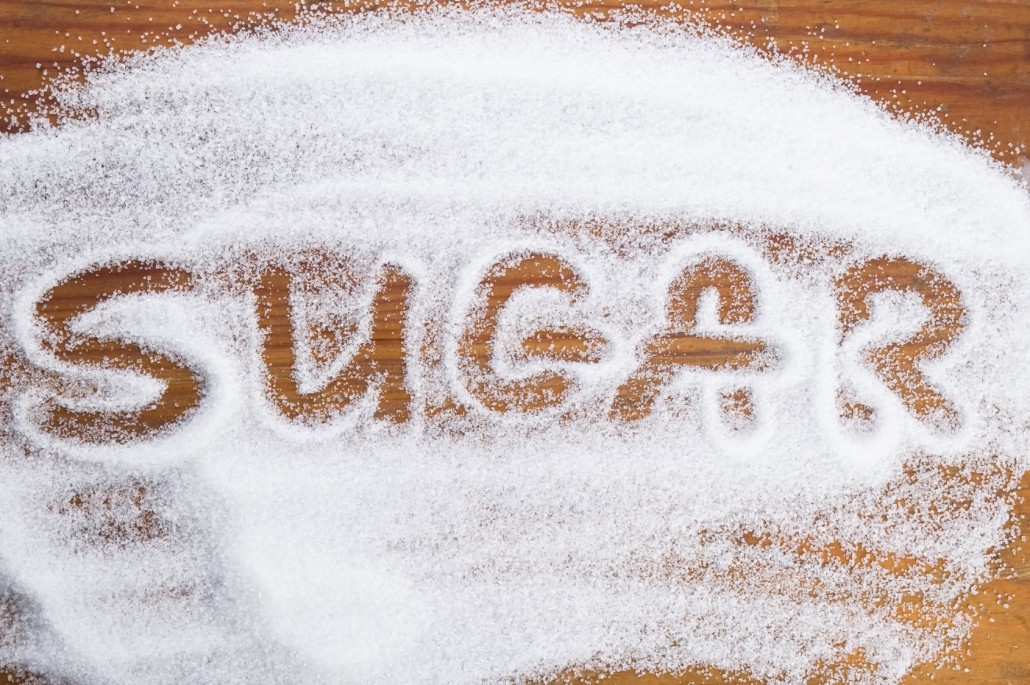Dietary guidelines for Americans were first published in late 1970’s giving birth to the development of the low-fat revolution. During this time, we were encouraged to consume less saturated fat. In other words, it was a push to have us eat less of the conventional foods we were used to like meat, butter, full-fat dairy and eggs.
The recommendations were recognized, and adhered to, by the food industry as they quickly shifted to accommodate the many foods they produced to match the main public health message that saturated fat was indeed bad and needed to be lowered in our over-all diets.
The food industry soon realized that when they removed the fat from food the taste was severely compromised. So what did they do to make the food more palate pleasing? They turned to their magic bullet – SUGAR. And, unbeknownst to the general public, they added a whole bunch of sugar to their foods to replace the fat they removed.
Although sugar was never endorsed by public health guidelines, the sole emphasis was to reduce saturated fat, which they successfully did. However, saturated fat was actually healthier and more beneficial to our bodies than we realized, and the added sugar was anything BUT healthy or beneficial.
Today, people are eating massive amounts of added sugars – usually without even realizing it.
In 1800, on average, we consumed just 10 pounds of sugar per year. Today, we’re consuming upwards of 100 pounds per year. Now keep in mind that this is “on average” and teenagers and young adults are actually consuming closer to 130 pounds of sugar per year while many other individuals are eating even more.
So what’s all the hype about SUGAR and is it really that bad?
Maybe not in small amounts, BUT in the amount Americans consume today YES, it can be downright toxic.
Let’s look at some of the reasons why sugar is bad
Sugar is nutritionally deficient
You’ve probably heard this a million times before but it’s definitely worth repeating. Sugar contains a lot of calories, with no essential nutrients.
For this reason, sugar is called an empty calorie.
There is no protein, essential fats, vitamins or minerals in sugar. Sugar is just pure energy calories. This is why when people eat a large percentage of their calories as sugar (mostly unknowingly) it becomes a primary catalyst to nutrient deficiencies.
Sugar is also very easily digestible, and being the main energy supply for bad bacteria, it can create a multitude of issues including leaky gut and autoimmune disorders.
Sugar leads to increases in insulin
Insulin is a hormone made in the pancreas. It plays a major role in your metabolism – basically, the way the body uses digested food for energy. The digestive tract breaks carbohydrates down into sugars found in the many processed foods and starches we consume. Those sugars then enter the bloodstream. With the help of insulin, cells throughout the body absorb those sugars and use it for energy. When the supply of sugar is greater than what the body needs for energy, insulin (being a fat storing hormone) transports the excess sugars directly to your fat cells to be stored as body-fat for future energy.
Sugar is highly inflammatory
Sugar plays a large part in weight gain, and in the development of chronic, long-lasting, inflammation in the body. Chronic inflammation has a damaging effect on the body over time, without any signs or symptoms. Scientists have found that complex interactions in fat tissue draw immune cells to the areas which trigger chronic inflammation. Inflammation has been sighted as a main contributor to the development of weight gain, obesity, insulin resistance, type II diabetes, cardiovascular, neurologically disorders and autoimmune diseases.
High sugar diets are linked to increased risk for cancer
Cancer is one of the leading causes of death worldwide and is characterized by uncontrolled growth and multiplication of cells. Insulin happens to be one of the key hormones in regulating this sort of growth.
For this reason, many scientists believe that having constantly elevated insulin levels (a consequence of sugar consumption) can contribute to cancer.
In addition, the metabolic problems associated with sugar consumption are a known driver of inflammation, another potential cause of cancer. Multiple studies show that people who eat a lot of sugar are at a much higher risk of getting cancer.
Sugar can be downright addictive
Sugar can be highly addictive for many of us. Like other addictive drugs, sugar causes a release of dopamine in the reward center of the brain.
The problem with sugar is that it can cause a massive dopamine release, much more than we were ever exposed to from naturally sweetened foods found in nature. For this reason, people who have a susceptibility to addiction can become strongly addicted to sugar and many of the junk foods we so readily consume in our everyday diets.
The “everything in moderation” message that we are plagued with daily may be a bad idea as well – especially for people who are addicted to sugary foods because the only thing that works for true addiction is complete abstinence.
Sugar is linked to Alzheimer’s the new “Type 3 Diabetes”
Back in 2005 breaking news about new insight into the cause of Alzheimer’s disease first emerged. At that time it was highly speculative, but today surmountable evidence point to Alzheimer’s as a form of diabetes, and the name being given to it is type 3.Due to the sugar-insulin link to the brain the onset of Alzheimer’s has now been considered a form of diabetes specific to the brain.
Insulin resistance, the defining symptom of type II diabetes, is now being considered the equivalent in the case of Alzheimer’s to lack of insulin. Since type II diabetes is mainly developed as a result of a poor diet, high in sugar and processed foods, one of the preventative measures now being looked at is for people at genetic risk of Alzheimer’s is to go on a type II diabetes diet low in sugar and processed carbohydrates. (1)
What is a safe amount of sugar?
Unfortunately, there is no simple answer to this question. While some people are able to eat a respectable level of sugar without harm, others should avoid it as much as possible.
According to the American Heart Association (AHA), the maximum amount of added sugars you should consume per day is:
- Men: 150 calories per day (37.5 grams or 9 teaspoons).
- Women: 100 calories per day (25 grams or 6 teaspoons).
To put this into better perspective, one 12oz can of coke contains 140 calories from sugar, while a regular sized snickers bar contains 120 calories from sugar.
If you are healthy, lean and active, these seem like reasonable amounts. You’ll probably burn off these small amounts of sugar without them causing you any harm. On the other hand, if you are overweight, obese, diabetic or suffering from any metabolic issues then you should try to completely avoid any sugar in your diet. It is very important to note that there is no need for any added sugars in one’s diet. Sugar serves absolutely no physiological purpose to our bodies so the less you eat the healthier you will be. (2)
Here are 7 easy ways to reduce the sugar in your diet
Over the years I’ve been able to help many of my clients seriously reduce the amount of added sugar in their diet by simply teaching them to pay more attention to a product’s ingredient list.
1. Begin with beverages
You’re not exactly “eating” a soda, but the calories and added sugar still counts. Today, Americans consume 200 to 300 more calories per day than they did 30 years ago, and nearly half of those calories come from sugary drinks.
Soda is the most recognized culprit as far as sugar-sweetened beverages are concerned, but other soft drinks like fruit punch, lemonades, and energy drinks typically have as much or more added sugar as full-calorie soda. Cutting down from two per day to one can add up to 16 pounds of weight loss in a year.
2. Know your nicknames
Food manufacturers have come up with some pretty creative names for added sugar over the past few years, making it nearly impossible to pick them out if you don’t know what you’re looking for. In my new downloadable ‘Virtual Nutrition Program’ I teach you how to become a master sugar detective so you will never be fooled again by the 36 most commonly used hidden sugar names.
3. Navigate ingredient lists
Now that you can spot added sugars in a list of ingredients, it’s time to start reading them! Going completely added-sugar free is nearly impossible, but this simple trick can help you find healthier options in the supermarket.
When comparing foods with added sugars such as cereals, breads and salad dressings, go for the ones that contain less than 3 grams of sugar per serving, or ones that list sugar as the 5th ingredient or lower. Since ingredients are listed by weight, the lower down sugar appears on the list the less you’ll be eating.
4. Spot the sneaky sources
Foods don’t necessarily have to taste sweet to contain added sugar. In fact, sugar is present in most of the packaged foods we consume, even the savory ones you’d never suspect. Some common sneaky sources of added sugar are: Packaged breads, salad dressing, Asian sauces, frozen dinners, cereals, fruit spreads, yogurt, instant oatmeal, vitamin enhanced waters, non-dairy milks and tomato sauces.
5. Swap in fruit
Instead of pouring sugar sweetened vinaigrette dressing all over your salad, add some fresh berries or sliced fruit. Same goes for yogurt: skip the fruit-at-the-bottom goop, and add fresh berries and nuts to plain yogurt instead. Fruit is a wonderful, natural source of sugar that also provides your body with fiber, vitamins, and minerals.
6. Make dessert special
I’m not saying never have them, but save the cookies, ice cream, cheesecake, and soda for special occasions, like a nice dinner out with friends or a weekend barbeque. If your meal needs a sweet finish, prep a big bowl of fruit salad on Sunday to help you curb any after-dinner cookie cravings during the week.
7. Realize it’s not all or nothing
Just because you want to “stop eating added sugar” doesn’t mean you need to cut out every last gram. Yes, you can still enjoy ketchup on your cheeseburger and your afternoon square of dark chocolate. To put a serious dent in decreasing your intake, start with the biggest sources, like soda, and foods you eat frequently, such as sandwich bread. Picking up no-sugar-added packaged foods, like pasta sauce and dressings, is another great place to start.


